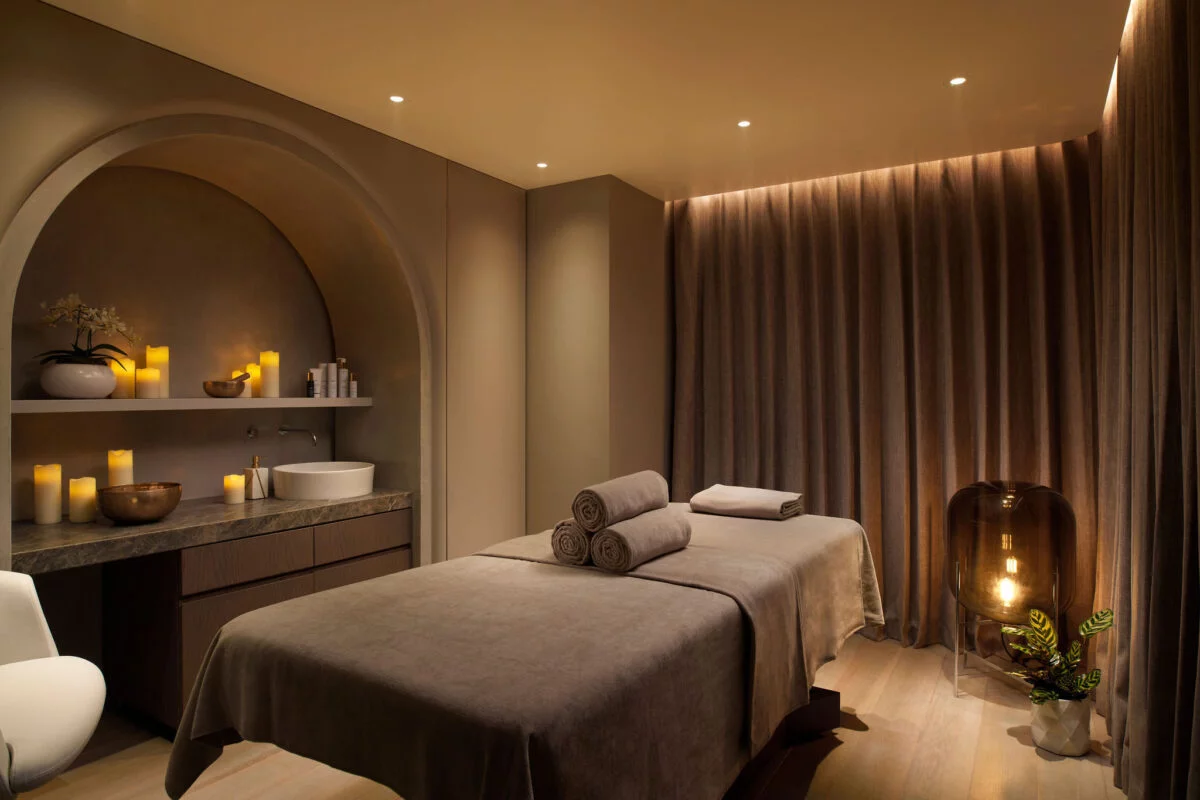The Evolution of Minimalism: More Than Just Bare Walls
For a long time, minimalist architecture has been defined by what you can see: straight lines, open spaces, and a single color scheme. It was a manner of thinking about art that stripped away decorations to show the true nature of shape and function. But as we get closer to 2025, the way people talk about minimalism is changing a lot. The focus is changing from what you can see to what you can feel deeply.
Minimalist design isn’t only about what isn’t there; it’s also about the things we can’t see that impact our experience. In Acoustic Minimalism, you may feel, hear, and smell the most luxury things instead of seeing them. This design theory promotes overall health by turning environments into peaceful, healing havens through the smart, often covert, use of sound, fragrance, and other sensory inputs.
Picture a modern, simple living room with big windows that look out on a lot of green space. There are no apparent speakers or diffusers, but the room feels peaceful and balanced. Focus on light and a hint of peaceful elegance.
The Science of Sensory Wellness in Design
Our homes are more than just places to live; they are parts of our nervous systems. Neuro-architecture, a new field, backs up what we already know: the places we live have a big effect on our mood, stress levels, and brain function. If the acoustics are bad, the artificial odors are too strong, or the lighting messes up our natural rhythms, a space that looks simple might nonetheless feel chaotic.
Acoustic minimalism tries to get rid of sensory overload. It’s about intentionally creating spaces that encourage calm, attention, and repair by making the most of the senses that are typically ignored. It’s not just about being quiet; it’s about making a soundscape on purpose. It’s not just about getting fresh air; it’s also about having a clean, subtle smell. This all-encompassing approach is becoming a sign of true luxury and wellbeing in minimalist design.
 Tapestra Acoustical Ceiling Baffles by Arktura
Tapestra Acoustical Ceiling Baffles by Arktura
The Basics of Acoustic Minimalism: Making Things That Aren’t There
The Art of Hidden Sound: More Than Silence
In minimalism, “acoustic design” doesn’t just mean soundproofing. It’s about soundscaping, which means purposely changing how a space sounds.
- Not Silence, But Less Noise: The goal isn’t to be completely silent, which can be hard to deal with. It’s not about getting rid of all echoes and outside noise pollution; it’s about making a regulated sound environment. This includes thinking about how sound moves, bounces, and gets absorbed.
- Invisible Acoustics: By 2025, this will imply seamlessly integrating acoustic solutions. Consider ceiling panels with tiny holes that seem like plaster, wall coverings with fabric backs that look like basic upholstery, or furniture that is situated in a way that also dampens sound. Even speakers that are hidden can play carefully chosen, calming sounds in the background, like white noise or natural sounds, without being seen.
- Materiality Matters: The materials you choose are very important. Soft furnishings, rugs, wooden pieces, and even textured concrete can soak up sound better than hard, shiny surfaces like glass and polished stone.
 Cove Baffle System by Zintra
Cove Baffle System by Zintra
The Quiet Power of Smell: Olfactory Design
The limbic system, which is in charge of memory and emotion, is closely connected to our sense of smell. In minimalist design, olfactory design is all about making a clean, simple, and mood-boosting aroma profile without using strong synthetic scents.
- Designing for Air Quality: The base is clean air. Advanced, hidden HVAC systems with multi-stage filtration (HEPA, activated carbon) make sure the air is clean, fresh, and smells good.
- Natural Essences: Subtle, natural scents from essential oils like cedarwood, bergamot, and frankincense can be diffused through built-in systems from time to time. This can help you rest, focus, or feel better. These aren’t designed to be strong; they’re meant to make the air seem clean and fresh.
- Material Off-Gassing: Choosing materials with minimal VOC (Volatile Organic Compound) emissions is an important part of “clean scent” since it keeps the home’s natural smell clean instead of chemical.
 TrueTile® by Focal Point Lights
TrueTile® by Focal Point Lights
Dynamic Light and Thermal Comfort: The Energy You Can’t See
A minimalist retreat needs more than just looks; it needs properly controlled light and a constant level of thermal comfort.
- Circadian lighting systems: The way of the future for illumination in minimalist houses. Integrated LED systems change their color temperature and brightness automatically throughout the day to look like natural daylight. This helps our natural circadian rhythms, which makes us sleep better, feel better, and work better, all without any obvious dimmer switches or complicated fixtures.
- Passive and active thermal control: Minimalist buildings frequently have a lot of glass. Passive methods like deep overhangs, strategic planting, and thermal mass, as well as hidden active systems like underfloor heating and cooling and zoned HVAC, are used in intelligent design to keep the temperature just right without adding visible clutter. The design goal is the “feel” of the air, not how it works.
 BuzziReForm by BuzziSpace
BuzziReForm by BuzziSpace
Combining the Invisible: Useful Uses for 2025
The key for architects and designers who want to use Acoustic Minimalism is to start working together and integrating early on.
- Early Planning: You need to think about sensory design from the very beginning. This means talking to acoustic engineers, lighting experts, and HVAC experts from the very beginning.
- Choosing materials: Choose natural, low-VOC materials that naturally absorb sound, such wood, cork, and natural fibers.
- Smart Home Integration: Use hidden smart home technology to regulate lighting, temperature, and smell diffusion, making the sensory experience easy and smooth.
- Biophilic Elements: Add living plants, regulated water features, or vistas of nature to bring in natural sounds, smells, and sights that calm you down. This is Biophilic Design and Acoustic Minimalism coming together.
 Veil Design from the Emma Hayes collection by Autex Acoustics®
Veil Design from the Emma Hayes collection by Autex Acoustics®
Conclusion: The Future is Something You Can Feel, Not Just See
Acoustic Minimalism isn’t just a trend; it’s a big change in how we think about health and happiness in the places we build. As our lives get more complicated and noisy, more and more people will want places that really help them relax and restore their senses. Architects and designers in 2025 are setting a new standard for minimalist luxury by mastering the art of the invisible, which includes sculpting sound, curating aroma, and getting light and temperature just so.
When you walk into a minimalist setting that really inspires you, take attention to how it makes you feel as well as what you see. The genuine design genius might be right in front of you, working quietly to soothe your mind and feed your senses.
 Credit: Julie Thong/ Source pinterest.com
Credit: Julie Thong/ Source pinterest.com
FAQs About Acoustic Minimalism
What is Acoustic Minimalism?
A: Acoustic Minimalism is a design style that focuses on making a space’s non-visual sensory experience as good as possible. This includes sound, smell, and comfort with temperature and lighting. It often uses concealed or seamlessly integrated design solutions to make spaces that are calm and restorative.
Q2: What makes it distinct from regular Minimalism?
A: Traditional minimalism puts a lot of emphasis on clean lines, visual simplicity, and getting rid of clutter. Acoustic Minimalism improves on this by adding a layer of sensory design that focuses on things like echoes, air quality, and light dynamics that are typically ignored to improve overall health.
Q3: Is Acoustic Minimalism just for fancy homes?
A: High-tech sensory integration may start in high-end environments, but anyone may use the ideas of thinking about sound, light, and air quality. Choosing simple materials, carefully placing furniture, and paying attention to natural ventilation can make any minimalist environment much better.
Q4: How can you use these ideas in real life?
A: Use soft furniture like rugs and drapes to absorb sound, use materials with low VOCs, add plants to improve air quality, and make the most of natural light. For more advanced options, think of smart circadian lighting, hidden acoustic panels, and improved air filtration systems.
Q5: How does technology fit into Acoustic Minimalism?
A: Technology is very important for providing subtle, automated sensory experiences. Smart home systems that are hidden may change the color temperature of the lights, clean the air, and even make background sounds that are quiet, making it easy for the user to enjoy the sensory environment.
Reference:
How Acoustic Materials Are Elevating Interior Design in 2025 – Architecture Magazine
For more blogs CLICK HERE!!





